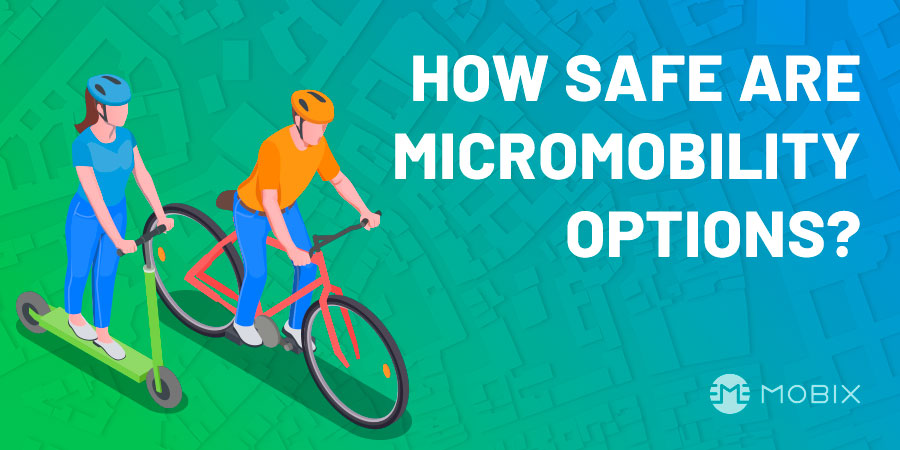One concern that is frequently touted in legislative discussion in regards to micromobility solutions is safety. In this post, we’ll be examining the latest statistics surrounding micromobility usage and briefly contrasting them with vehicular transport. How safe are micromobility options?
Micromobility Safety, the Media and the Statistics
Accidents are inevitable, a part of life, but some recent reports into micromobility safety have found that, at least in the micromobility sphere, they happen far less than many may think. This is perhaps due to the adverse and relatively jarring (not to mention sensationalist) media coverage of these fatalities.
Due to the speed limits imposed on many micromobility solutions through regulatory action (scooters, for example, are being limited in many jurisdictions to roughly 25mph), fatalities are actually very rare. An ITF report (mentioned in a London assembly report) has recently highlighted that micromobility solutions, namely electronic scooters and bikes, are as safe as riding a regular bike, despite their slightly higher speeds.
In a recent JAMA network study on micromobility safety, it has been noted that just two serious injuries (requiring emergency medical care) had been the result of approximately 3 million safely completed journeys (a serious incident rate of 1 per 1.5 million rides). In addition, over in the US, there is an overall scooter incident rate of just 1.9 per 100,000 rides, according to the Center for Disease Control (CDC)… and that rate can be reduced down to 0.02 per 100,000 rides for those that wear helmets when they ride.
Of the 22 fatalities since 2018 in the US, the Governors Highway Safety Association has noted that all but 3 were actually the result of vehicular collision, which echoes the ITF’s findings that micromobility solutions are as safe as regular bike riding (the most dangerous aspect of which is actually vehicular collision, typically resulting due to the fault of the driver).
To read the ITF’s full report on micromobility safety, see here.
The Vehicular Contrast
Overall, when examining vehicular fatality rates- the numbers are staggering. In the U.S., in 2016, there were approximately 102 car-related fatalities a day. This does not include injury rates or related fatalities.
There will always be risk involved in transport, if not everything we do as humans, and I would like to note that it is not the goal here to point out that micromobility solutions are ‘better’ than cars. Further, it is natural for policymakers to be concerned about citizens injuring themselves when using new technology and transport options, but from the figures, it is clear that the dangers of micromobility solutions are disproportionately discussed when accounting for actual fatality numbers.
(Considering the horrifying nature of the figure above, I would also briefly share the good news that car-related fatalities worldwide have been declining since 2009.)
The Safety Economy
Of relevance to the topic of safety, but not concerning injury, is how micromobility is likely to be seen as safer than other transport options in the future. This is because in the new ‘safety economy’ (a term coined following the Covid-19 pandemic) citizens are more concerned with minimising their interactions with other individuals, so will be more willing to take micromobility options over ride-hailing or crowded public transport. If you’d like to read more about this topic and the concept of the safety economy, see here.
Smart Limits – a Potential Solution
From the data available, and also perhaps a smidgeon of common sense, it is clear that there is a rough correlation between speed and the chance of an accident occurring. Many countries have already noted this and, as mentioned, implemented speeding limits on micromobility solutions. As was also noted above within the CDC figures, injury incident rates on scooters decrease considerably when users are wearing helmets.
Thus, a potential solution is for ‘smart limits’ to be implemented via an app-based solution. Limitations on scooter speed could vary depending upon whether the user is wearing a helmet, possesses a driving license, is a first-time user, possesses insurance, has been drinking, is riding at night, is planning on riding through a ‘hazardous’ area (based on previous data) or ‘double riding’ is suspected. As you can see- and perhaps is obvious- there are a large number of factors that impact ride safety.
However, all of this data could be anonymously shared via a method such as Datarella’s smart SSI infrastructure and used to determine overall ride risk! I would note that this is a new idea, but in this new age of micromobility, this concept could present an innovative manner in managing injury risk.
What do you think? Let us know on Twitter or on our Telegram group. Let’s talk micromobility!

